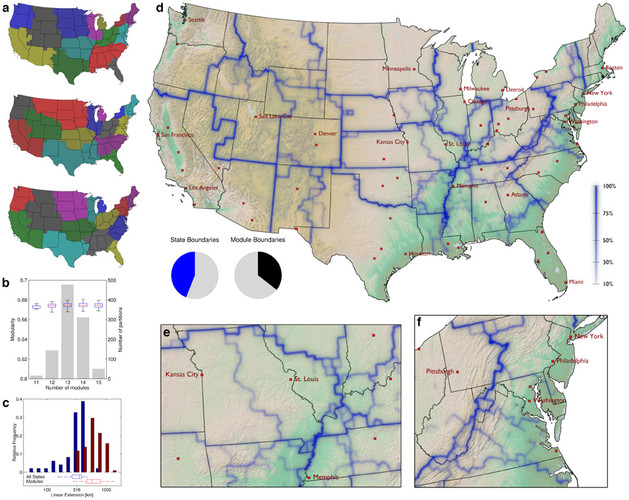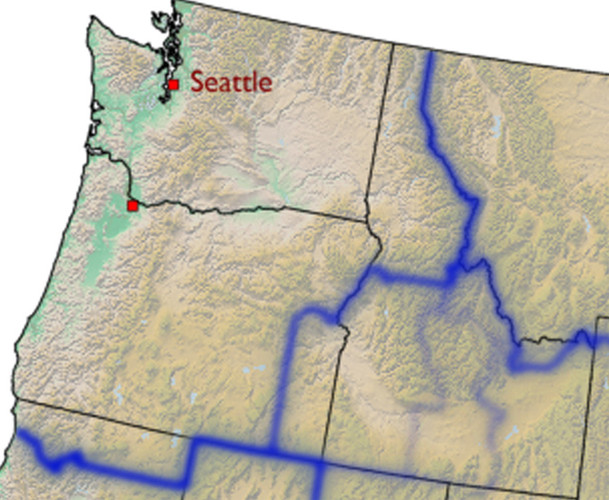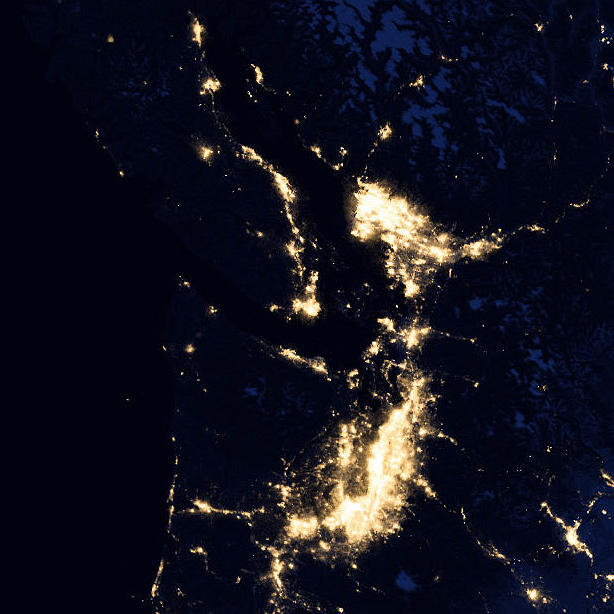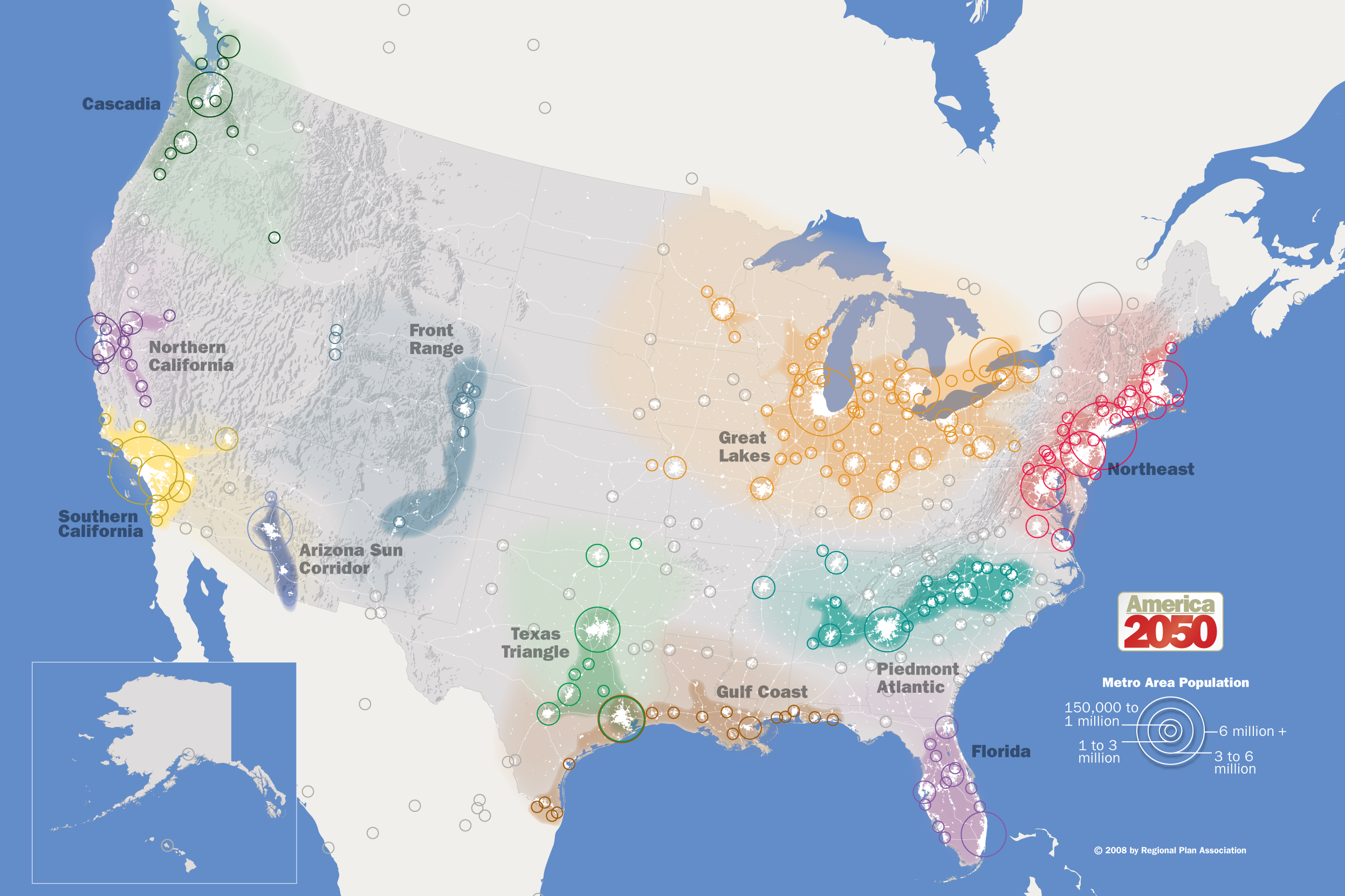In very exciting news, David McCloskey's new map of the Cascadia bioregion has been chosen to grace the cover of the new 2015 map book being put out by the geography organization ESRI. It will also be featured at their upcoming conference.
What is Bioregionalism?
As a Megaregion
An Introduction to Cascadian Bioregionalism
About Cascadia
The way our money moves: Cascadia defined by regional economy
In a recent article published on Facts CoExist theoretical physicist Dirk Brockmann argues that state boundaries are often arbitrary and out of date, no longer representative of how we communicate or function as a modern society. By tracking dollar bills he has created a series of maps redrawing state borders by how our money moves, which more accurately portrays distinctive areas based on regional economy.
When mapped in this fashion, Cascadia once again emerges, clearly delineated along a bioregional line.
Analyzing data from millions of single dollars, using information provided by the WheresGeorge.com project, Brockmann determined that state boundaries no longer correlate with how we move or communicate with each other. WheresGeorge.com is a grassroots money tracking group in which users enter zip codes and serial numbers of dollar bills, stamping each one so that when other users find it, it can be relogged. Each time this happens, users receive a hit, the top ‘Georger’ at the moment being an ammunition dealer who has logged more than two million bills, with roughly 500,000 hits.
Brockmann took the data for how the dollar bills traveled, and used network theory to draw lines where dollar bills are less likely to cross. The resulting map shows how "effective communities" don’t necessarily follow state lines.
This research continues to build on a wide range of data visualizations that support the idea of Cascadia as socially, linguistically, economically, environmentally and politically distinct from surrounding regions. The work builds on research released in December by MIT Senseable Cities Lab who working with AT&T defined regions based on who people communicate with, through social media and via telephone.
 The result findings are also very similar to what the federal policy and planning organization America 2050 has argued, defining roughly 11 megaregions in the United States. America 2050 is Regional Plan Association’s national infrastructure planning and policy program, providing leadership on a broad range of transportation, sustainability, and economic-development issues impacting America’s growth in the 21st century. Investigating these social interactions reveals interesting patterns for how people utilize space, and more than that, interact not only within that space, but with society at large, between neighborhood, city, county, state and region, defining what community really means in 21st century America.
The result findings are also very similar to what the federal policy and planning organization America 2050 has argued, defining roughly 11 megaregions in the United States. America 2050 is Regional Plan Association’s national infrastructure planning and policy program, providing leadership on a broad range of transportation, sustainability, and economic-development issues impacting America’s growth in the 21st century. Investigating these social interactions reveals interesting patterns for how people utilize space, and more than that, interact not only within that space, but with society at large, between neighborhood, city, county, state and region, defining what community really means in 21st century America.
In this newly regional model, cities play an important role, helping to pull nearby counties into their radius of influence, create commuting patterns, influence economic and environmental landscapes, and when they overlap, combine to create a new form of spatial geography and interaction known in the Pacific Northwest as the Cascadia Megaregion, defined as an area where “boundaries begin to blur, creating a new scale of geography”. These areas have interlocking economic systems, shared natural resources and ecosystems, and common transportation systems link these population centers together. In the Pacific Northwest, the Cascadia megaregion contains 17% of Cascadian land mass, but more than 80% of the Cascadian population.
These arguments also help to strengthen the idea that while we here in the Pacific Northwest are a part of very large countries, the United States and Canada, we still possess distinct cultural elements – language, literature, affiliations, communications – and an awareness of ourselves as members of a community which extends throughout our region, rendering many traditional boundaries obsolete and irrelevant.
Cascadia in the Dark - A Striking Satellite Photograph
The Connected States of Cascadia - MIT Study Shows More Connected than Ever Before
Researchers at MIT Senseable City Lab, working with AT&T Labs and IBM Research have revealed a very nice set of data visualizations that redefines regional boundaries within the United States, using patterns of social connectedness derived from aggregated cellphone communication patterns. The project, "The Connected States of America" illustrates emerging communities defined by social interaction. The Cascadia bioregion features prominently in the illustrations, with the connections helping to better represent the social and cultural realities that are emerging in the Pacific Northwest, and the increasing fragmentation and cultural clustering currently underway throughout the rest of the country.
"Our interactions define new communities... which go beyond traditional state boundaries... with states splitting and merging together "
The data visualizations were derived from 2011 studies by looking at billions of instances of aggregated cell phone communications, working to redefine communities through the informal lens of social networks, hopefully allowing policy makers to utilize the data to increase the democratic process. Carlo Rotti, director of MIT Senseable Labs stated: "We are particularly interested in how such rich information can help us gain a better understanding of our society, which in the future, could lead to more democratic, bottom-up structures of governance."
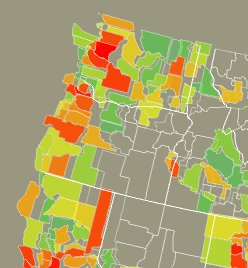 Investigating these social interactions reveals interesting patterns for how people utilize space, and more than that, interact not only within that space, but with society at large, between neighborhood, city, county, state and region, defining what community really means in 21st century America. In this newly regional model, cities play an important role, helping to pull nearby counties into their radius of influence, create commuting patterns, influence economic and environmental landscapes, and when they overlap, combine to create a new form of spatial geography and interaction known in the Pacific Northwest as the Cascadia Megaregion.
Investigating these social interactions reveals interesting patterns for how people utilize space, and more than that, interact not only within that space, but with society at large, between neighborhood, city, county, state and region, defining what community really means in 21st century America. In this newly regional model, cities play an important role, helping to pull nearby counties into their radius of influence, create commuting patterns, influence economic and environmental landscapes, and when they overlap, combine to create a new form of spatial geography and interaction known in the Pacific Northwest as the Cascadia Megaregion.
In addition to this, working on a bioregional framework also appears to be important and researchers found that Mountain ranges and other geographic features influence how people interact, because they contribute to an increased perception of distance and therefore hinder communication.
The result findings are also very similar to what the federal policy and planning organization America 2050 has argued, defining roughly 11 megaregions in the United States. America 2050 is Regional Plan Association's national infrastructure planning and policy program, providing leadership on a broad range of transportation, sustainability, and economic-development issues impacting America's growth in the 21st century.
A megaregion is defined as an area where “boundaries begin to blur, creating a new scale of geography”. These areas have interlocking economic systems, shared natural resources and ecosystems, and common transportation systems link these population centers together. In the Pacific Northwest, the Cascadia megaregion contains 17% of Cascadian land mass, but more than 80% of the Cascadian population.
These arguments also help to strengthen the idea that while we here in the Pacific Northwest are a part of very large countries, the United States and Canada, we still possess distinct cultural elements – language, literature, affiliations, communications – and an awareness of ourselves as members of a community which extends throughout our region, rendering many traditional boundaries obsolete and irrelevant. This idea of common bonds and character – are transmitted through media, newsprint, education, sports, and at it’s base root – our individual communications on an interpersonal level.
The Pacific Northwest is unique – in North America, and in the world abroad. We continue to be connected in ways that challenge traditional modes of governance, aspiring to better ways of conceiving of community, locality, geography, and ecology.
More information can be found on the MIT website: http://senseable.mit.edu/csa/











